A Biography of Matinee Idol Errol Flynn

A Biography of Matinee Idol Errol Flynn
by Shawn Dwyer, ThoughtCo, Updated March 17, 2017

A larger than life figure who burned brightly both on and off screen, Errol Flynn engaged in an adventurous lifestyle behindthe scenes that rivaled his dashing performances in some of classic Hollywood’s most iconic movies.
Flynn was synonymous with swashbuckling adventure and became an overnight star on the strength of his performances in Captain Blood (1935), The Charge of the Light Brigade (1936) and The Adventures of Robin Hood (1937). In fact, while many actors played Robin Hood, only Flynn has singularly been identified with the role.
Because of his limited acting ability – he never earned an Academy Award nomination – Flynn constantly fought against being typecast throughout his career. During his peak, he ran into legal trouble because of his dalliances with two teenage girls but was ultimately vindicated.
His career sagged after World War II and Flynn never recovered. Making matters worse was a growing dependence on alcohol and painkillers that would ravage his health and contributed to his death at 50 years old. Despite flaming out at a relatively young age, Flynn lived on as one of classic Hollywood’s greatest matinee idols.
Early Life
Born on June 20, 1909, in Hobart, Tasmania, Australia Errol Leslie Thomson Flynn was raised primarily by his father, Theodore Flynn, a lecturer and later professor of biology at the University of Tasmania. Flynn maintained a distant relationship with his mother, Mary, who left the family after a move to Sydney in 1920.
A troublemaker almost from the start, Flynn was expelled from grammar school when he was 17 for fighting and having sexual relations with the school’s laundress. Soon after, he made his way to New Guinea, where he later claimed to have worked as a diamond smuggler, charter-boat captain, and bird trapper while landing in hot water with the law and the husbands of women with whom he had numerous affairs.
A Turn to Acting
In the early 1930s, Flynn left Australia for England, where he began acting on the stage for a repertory company at the Royal Theatre while also performing in productions in London’s famed West End. Prior to his move to London, Flynn had made his film debut in the Australian-made adventure, In the Wake of the Bounty (1933), a retelling of the 1789 Mutiny on the Bounty that preceded the more famous 1935 version starring Charles Laughton and Clark Gable.
Signed to a contract by Warner Bros., Flynn made his leading debut in Michael Curtiz’s swashbuckling adventure, Captain Blood (1935), where he played a physician turned buccaneer ruling the high seas in Jamaica. One of the best adventure movies of its time, Captain Blood turned Flynn into an overnight sensation while marking the first of numerous collaborations with Curtiz and co-star Olivia de Havilland.
Though already notorious for his womanizing, Flynn married French actress Lili Damita that same year, resulting in a tempestuous relationship that ultimately ended in divorce in 1942. But Despite his torrid personal life, Flynn was rapidly becoming a major star with The Charge of the Light Brigade (1936) and Curtiz’s adaptation of Mark Twain’s The Prince and the Pauper (1937).
The Adventures of Robin Hood
But everything up to this point was mere prologue for his iconic leading turn in The Adventures of Robin Hood (1938), Flynn’s most iconic film of his career. Working once again with director Cutiz and co-starring opposite de Havilland, Flynn was at his dashing best playing the devil-may-care Sir Robin of Locksley, who runs afoul of prissy Prince John (Claude Rains) by robbing from the rich in order to pay the ransom of the imprisoned King Richard the Lionheart (Ian Hunter).
Not only did he become an international star because of the film, but Flynn also became synonymous with the role itself. Utter the name of Robin Hood and most minds automatically flash to Flynn with his hunter green shirt and long bow swooping in on a vine with a wink and a smile.
Peak of His Career
Flynn reached the pinnacle of his career in the late 1930s and in the early 1940s as the star of a wide variety of films, including romantic comedies like Four’s a Crowd (1938), costume dramas like The Private Lives of Elizabeth and Essex (1939) starring Bette Davis, and Westerns like Dodge City (1939) and Virginia City (1940). All of which were directed by Michael Curtiz.
But he was always at his best cutting a dashing figure as a swashbuckler in films like The Sea Hawk (1940), where he played a bold sea captain who prowls the high seas in search of gold and ships on behalf of Queen Elizabeth I (Flora Robson).
Flynn displayed his cavalier side as the flamboyant General George Armstrong Custer in Raoul Walsh’s historical epic, They Died With Their Boots On (1941), a rather forgiving account of Custer’s fateful encounter at Little Big Horn in 1876.
A Public Scandal
Right when he was becoming one of Hollywood’s most bankable stars, Flynn’s notorious large appetite for partying and sex caught up with him in 1942 when he was charged with statutory rape following his dalliance with two teenage girls. While mere mortals would have been ruined by such a scandal, Flynn found his reputation as a ladies’ man enhanced by his trial and subsequent acquittal in 1943 with the help of public support from a group calling themselves the American Boys’ Club for the Defense of Errol Flynn. As a result, Flynn was more popular than ever and gave rise to the saying “In like Flynn.”
While contending with pending rape charges, Flynn became an Americanized citizen and tried to enlist in the army and fight in World War II, but was deemed unfit for service due to a variety of ailments that included a heart murmur, chronic back pain, and an assortment of venereal diseases.
Flynn Recovers
Despite his personal setbacks, which also included divorce from Damita in 1942, Flynn delivered a number of quality performances, most notably in Raoul Walsh’s Gentleman Jim (1942), a boxing-themed biopic about the lovably arrogant 19th-century pugilist, James J. Corbett.
After marrying his second wife, 18-year-old Nora Eddington, who worked at the courthouse where his statutory rape trial was held, Flynn tried to make up for his wartime unfitness with a number of war movies like Desperate Journey (1942), Northern Pursuite (1943), Uncertain Glory (1944) and Objective, Burma! (1945), a financial flop that has later been deemed one of his greatest movies. It was also his last film with Walsh.
A Career in Decline
Following the war and the negative publicity he received for not serving – his studio kept the reasons for his unfitness out of the public eye – Flynn’s career hit a long, steady decline that was accentuated by a growing dependence on alcohol and painkillers. He had a brief return to his swashbuckling glory with the title role in The Adventures of Don Juan (1949), but he was largely relegated to B-movie parts for the remainder of his career.
Flynn delivered an acceptable performance as a cold, manipulative husband opposite Greer Garson in That Forsyte Woman (1949) and took to the high seas one last time as the star of middling pirate adventures like Adventures of Captain Fabian (1951), Against All Flags (1952) and The Master of Ballantrae (1953).
He attempted a major comeback by self-financing The Story of William Tell in 1953 but managed to shoot only 30 minutes of the film before the project fell apart. As a result, Flynn was forced to make forgettable movies like Lilacs in the Spring (1954), The Warriors (1955) and King’s Ranso (1955) to pay off his debts.
An Ignominious End
In his waning years, Flynn spent his time in self-exile in Jamaica with third wife, actress Patrice Wydmore, and earned final acclaim as a drunken louse in the adaptation of Ernest Hemingway’s The Sun Also Rises (1957) and as classic movie icon acclaim as a drunken louse in the adaptation of Ernest Hemingway’s The Sun Also Rises (1957) and as classic movie icon John Barrymore in the aptly titled Too Much, Too Soon (1958).
As his health began to fail him in the 1950s, Flynn made the acquaintance of 15-year-old aspiring actress, Beverly Aadland, whom he intended to run away with to Jamaica. But while in Vancouver, British Columbia, Flynn fell ill during a party and retired to his bedroom. Aadland checked on him a half hour later and discovered that he had died of a heart attack in his sleep. His body was returned to Los Angeles, where he was interred in the Forrest Lawn Memorial Park Cemetery.
Posthumously, Flynn was notorious as ever. Accusations arose that he had been a Nazi spy and sympathizer during the war, though proof of such was never produced. Of course, speculation about his sexual adventures were ever-present, withclaims swirling that he engaged in all manner of activities with both sexes. But most claims were rejected as false.
Regardless of his reputations, deserved or undeserved, Flynn was a true icon of the silver screen. While never honored with an Academy Award.






